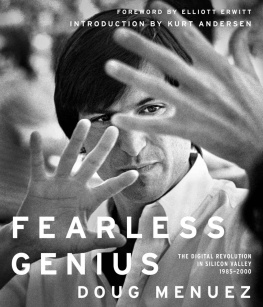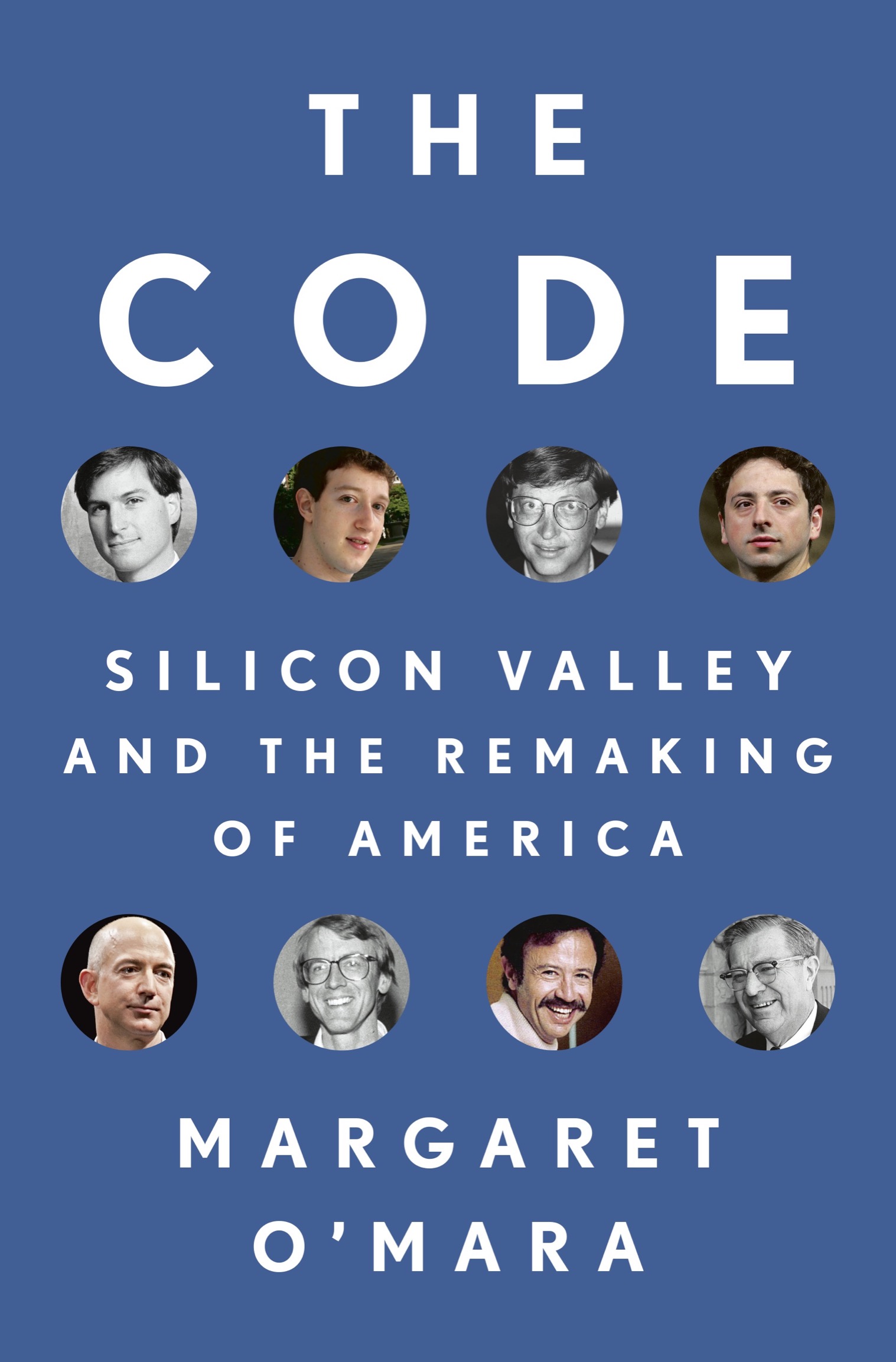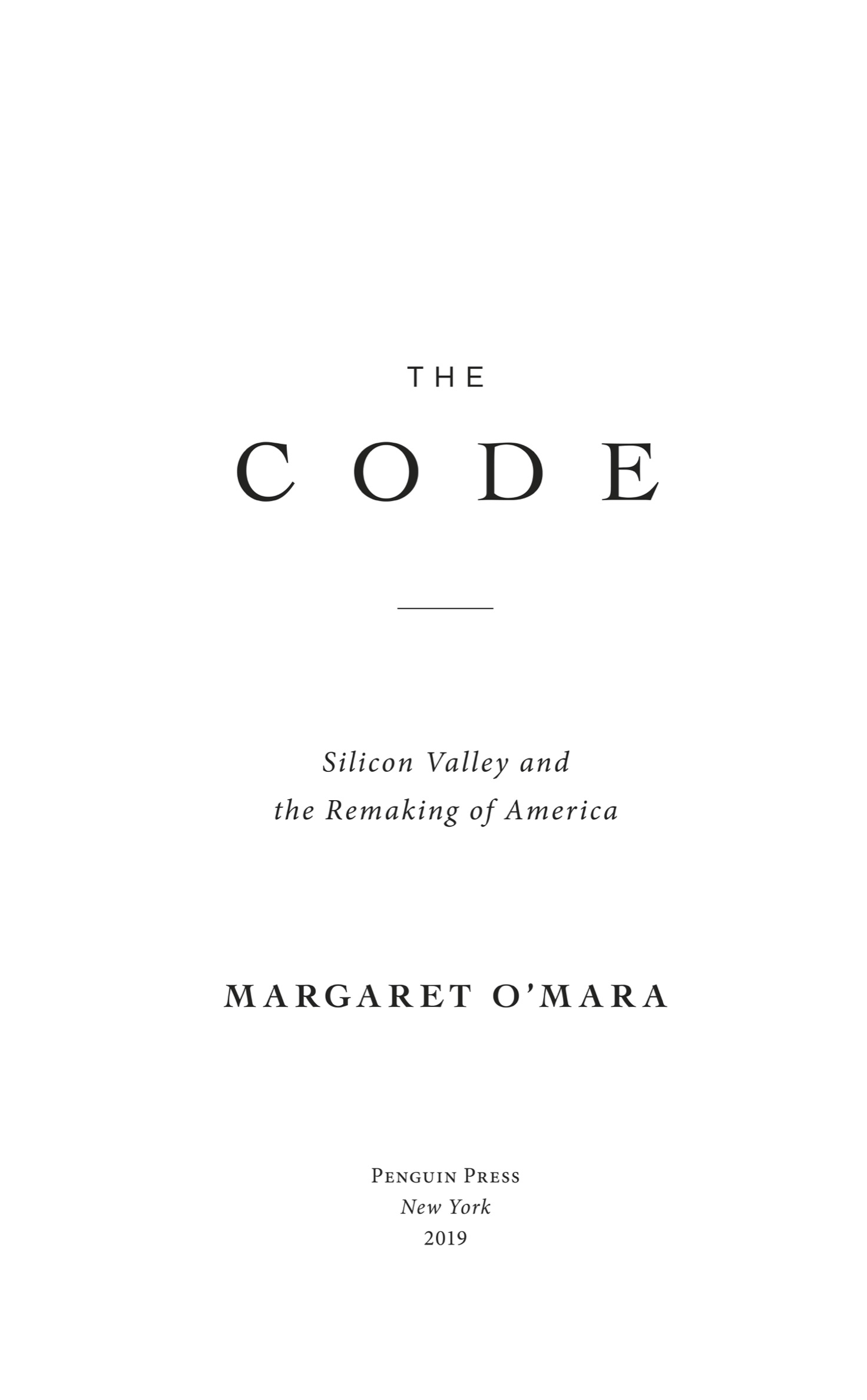A LSO BY M ARGARET OM ARA
Pivotal Tuesdays: Four Elections That Shaped the Twentieth Century
Cities of Knowledge: Cold War Science and the Search for the Next Silicon Valley
PENGUIN PRESS
An imprint of Penguin Random House LLC
penguinrandomhouse.com
Copyright 2019 by Margaret OMara
Penguin supports copyright. Copyright fuels creativity, encourages diverse voices, promotes free speech, and creates a vibrant culture. Thank you for buying an authorized edition of this book and for complying with copyright laws by not reproducing, scanning, or distributing any part of it in any form without permission. You are supporting writers and allowing Penguin to continue to publish books for every reader.
Photograph credits appear on .
LIBRARY OF CONGRESS CATALOGING-IN -PUBLICATION DATA
Names: OMara, Margaret Pugh, 1970 author.
Title: The Code : Silicon Valley and the remaking of America / Margaret OMara.
Description: New York : Penguin Press, 2019. | Includes bibliographical references and index.
Identifiers: LCCN 2019003295 (print) | LCCN 2019006563 (ebook) | ISBN 9780399562198 (ebook) | ISBN 9780399562181 (print)
Subjects: LCSH: Santa Clara Valley (Santa Clara County, Calif.)Economic conditions. | Business enterprisesCaliforniaSanta Clara Valley (Santa Clara County)
Classification: LCC HC107.C22 (ebook) | LCC HC107.C22 S33973 2019 (print) | DDC 338.709794/73dc23
LC record available at https://lccn.loc.gov/2019003295
Cover design: Christopher Brian King
Cover images: (top row) Steve Jobs, Andy Freeberg / Getty Images; Mark Zuckerberg, Rick Friedman / Getty Images; Bill Gates, PA Images / Getty Images; Sergey Brin, Justin Sullivan / Getty Images; (bottom row) Jeff Bezos, Ted Soqui / Getty Images; John Doerr, Ann E. Yow-Dyson / Getty Images; Andy Grove, courtesy of Intel Corp.; Frederick Terman, provided by the Stanford University Libraries
Version_1
To Jeff
Want to know why I carry this tape recorder? Its to tape things. Im an idea man, Chuck, all right? Ive got ideas all day long, I cant control them, its like, they come charging in, I cant even fight em off if I wanted to.
Night Shift (1982)
On behalf of the future, I ask you of the past to leave us alone. You are not welcome among us. You have no sovereignty where we gather.
J OHN P ERRY B ARLO W,
A Declaration of the Independence of Cyberspace, 1996
The machine that is everywhere hailed as the very incarnation of the new had revealed itself to be not so new after all, but a series of skins, layer on layer, winding around the messy, evolving idea of the computing machine.
E LLEN U LLMAN,
Life in Code, 1998
CONTENTS
LIST OF ABBREVIATIONS
ACM: Association for Computing Machinery
AEA: American Electronics Association
AI: Artificial intelligence
AMD: Advanced Micro Devices
ARD: American Research and Development
ARM: Advanced reduced-instruction-set microprocessor
ARPA: Advanced Research Projects Agency, Department of Defense, renamed DARPA
AWS: Amazon Web Services
BBS: Bulletin Board Services
CDA: Communications Decency Act of 1996
CPSR: Computer Professionals for Social Responsibility
CPU: Central processing unit
EDS: Electronic Data Systems
EFF: Electronic Frontier Foundation
EIT: Enterprise Integration Technologies
ENIAC: Electronic Numerical Integrator and Computer
ERISA: Employee Retirement Income Security Act of 1974
FASB: Financial Accounting Standards Board
FCC: Federal Communications Commission
FTC: Federal Trade Commission
GUI: Graphical user interface
HTML: Hypertext markup language
IC: Integrated circuit
IPO: Initial public offering
MIS: Management information systems
MITI: Ministry of International Trade and Industry (of Japan)
NACA: National Advisory Committee for Aeronautics, later superseded by NASA
NASA: National Aeronautics and Space Administration
NASD: National Association of Securities Dealers
NDEA: National Defense Education Act
NII: National Information Infrastructure
NSF: National Science Foundation
NVCA: National Venture Capital Association
OS: Operating system
OSRD: U.S. Office of Scientific Research and Development
PARC: Palo Alto Research Center, Xerox Corporation
PCC: Peoples Computer Company
PDP: Programmed Data Processor, a minicomputer family produced by Digital
PET: Personal Electronic Transactor, a microcomputer produced by Commodore
PFF: Progress and Freedom Foundation
R&D: Research and development
RAM: Random access memory
RMI: Regis McKenna, Inc.
ROM: Read-only memory
SAGE: Semi-Automatic Ground Environment
SBIC: Small Business Investment Company
SCI: Strategic Computing Initiative
SDI: Strategic Defense Initiative
SEC: Securities and Exchange Commission
SIA: Semiconductor Industry Association
SLAC: Stanford Linear Accelerator Center, later SLAC National Accelerator Laboratory
SRI: Stanford Research Institute, later SRI International
TCP/IP: Transmission Control Protocol / Internet Protocol
TVI: Technology Venture Investors
VC: Venture capital investor
VLSI: Very large-scale integration
WELL: Whole Earth Lectronic Link
WEMA: Western Electronics Manufacturers Association, later AEA
INTRODUCTION
The American Revolution
Three billion smartphones. Two billion social media users. Two trillion-dollar companies. San Franciscos tallest skyscraper, Seattles biggest employer, the four most expensive corporate campuses on the planet. The richest people in the history of humanity.
The benchmarks attained by Americas largest technology companies in the twilight years of the twenty-first centurys second decade boggle the imagination. Added together, the valuations of techs so-called Big FiveApple, Amazon, Facebook, Google/Alphabet, and Microsofttotal more than the entire economy of the United Kingdom. Tech moguls are buying storied old-media brands, starting transformative philanthropies, and quite literally shooting the moon. After decades of professed diffidence toward high politics, the elegant lines of code hacked out in West Coast cubicles have seeped into the political systems every corner, sowing political division as effectively as they target online advertising.
Few people had heard of Silicon Valley and the electronics firms that clustered there when a trade-paper journalist decided to give it that snappy nickname in early 1971. Americas centers of manufacturing, of finance, of politics were three thousand miles distant on the opposite coast. Boston outranked Northern California in money raised, markets ruled, and media attention attracted.
Even ten years later, when personal computers mushroomed on office desks and boy-wonder entrepreneurs with last names like Jobs and Gates seized the public imagination, the Valley itself remained off to the side of the main action. An ochre haze of smog hung over its tidy bedroom suburbs when the wind didnt blow right, its dun-colored office buildings were impossible to tell apart, and you were out of luck if you tried to order dinner in a restaurant past 8:30 p.m. One horrified British visitor called it the land of polyester hobbitry.




